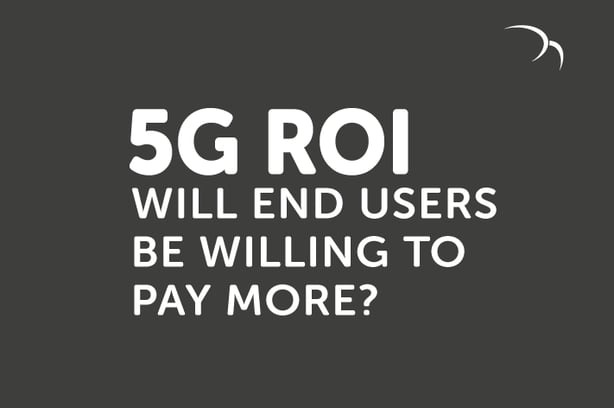5G ROI from an end-user perspective (Will end users be willing to pay more for 5G services?)
While CAPEX and OPEX aspects of deploying 5G networks and services are becoming clear to mobile operators and service providers, the other side of the revenue/cost equation is a bit more elusive.
In order to justify the huge investment in 5G services (e.g. in the spectrum, network infrastructure, site acquisition), their associated revenue streams should be significantly higher than, for example, those associated with 4G services.
So, are we talking about an increase in ARPU? Or an increase in customer base? Or perhaps both?
The answer is probably a combination of the two. As mentioned in our previous blog, 5G consists of three types of services – eMBB, mMTC, and URLLC. While eMBB enables improved service for an existing customer base in order to enhance competitiveness and raise ARPU, the other two services target a completely new market segment that will likely increase the customer base significantly.
Let’s review this, however, from the end-customer perspective. Will 5G services be worth the expense? Will existing and new customers be willing to pay significantly more to use those new, shiny 5G services?
In the case of a small-medium business, for example, let’s see how 5G and the technologies it enables may affect SMB. In particular, how will these technologies impact staff productivity?
Staff productivity, for one, is key to creating a successful and appealing ROI case for 5G business customers. As we will explain soon, 5G will dramatically increase the productivity of a typical business. This, in turn, will enable the business to achieve its same goals with fewer staff, to increase activity without additional staff, and to save on office, transportation, and IT-related expenses. In short, it will enable the business to increase revenues and reduce costs in a way that will deliver a definite ROI for the 5G services consumed.
This improved productivity will be due to the implementation of several technologies – autonomous vehicles, virtual office, massive IoT, AI, and others – that will require 5G services and infrastructure.
Autonomous vehicle
Autonomous vehicle technology will increase productivity by turning commuting time into work (or pleasure) time, thereby enabling employees to work more hours without compromising on leisure time. And the impact could be significant. For example, in the case of an average 10-hour workday and an average 1-hour commute in each direction, autonomous vehicles alone could improve productivity by 20%!
For this to happen, level-5 (full automation), or at least level-4 (high automation), autonomous vehicles will be required, since they will enable the driver (who then becomes a passenger) to focus on work instead of on driving. The connectivity requirements of these autonomous vehicles are enormous in terms of both capacity and coverage and latency and availability, and can be met only by 5G infrastructure.
Virtual office
Virtual office technology takes this trend one step further, and enables staff to work from, well, anywhere. With a solid, reliable, and ultra-high-capacity, always-on connection across all business systems, a worker could function as if he/she is in an office anywhere in the world. This will not only increase productivity (since it eliminates commuting time) but also save on OPEX, such as power, A/C, and real estate.
5G, again, is the enabling technology in this scenario due to the need for ultra-high capacity (think simultaneous video conferencing and high-volume file transfer) and availability.
Massive IoT
Massive IoT technology could also improve productivity for businesses that rely on data acquisition. In such instances, various sensor types and locations can easily gather road traffic, consumer-traffic, environmental, geo-location, and a broad range of other parameters, saving both time and money.
At the same time, any business or factory that runs machinery can also benefit from IoT and M2M, since remote machinery operations and monitoring become available and safe with 5G infrastructure.
AI technology
Lastly, AI technology, which automates and simplifies data analysis of any type, can clearly offload work from human staff and increase productivity. While AI is typically based in data centers, real-time connectivity to such technology requires a ubiquitous connection that is provided by 5G.
When looking at this broader scope, 5G and other technologies are valuable to most businesses – But will end-users be willing to pay more for these new services? The answer to this question is up to operators and service providers and their ability to convey the value these new 5G services offer them. They need to build 5G infrastructure that will enable the use cases discussed as well as others, and demonstrate them to both their existing and new customers.
To learn more, download our white paper:
5G Networks - Wireless and Fiber Backhaul Solutions


